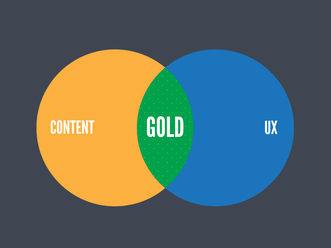
“Content is king!” “UX matters!” Unless you’ve been living under a rock for years, you’ve probably heard both of these statements at some point. And though there are many articles out there that discuss the importance of combining these two worlds, it’s becoming more and more evident that many brands and agencies are behind in truly reaching that Goldilocks Zone. It’s time we all go beyond our comfort zone of executing the traditional content marketing strategy and website design.
Battling Low Attention Spans with Engaging Content
When we think of content strategy, it's typical to automatically think of pillar pages, cluster articles, case studies, and white papers. One of the most challenging tasks for marketers is making those heavily-worded pieces engaging (and yes, even something as short as a blog article can be considered “heavily-worded”). Luckily user experience (UX) design can help.
It’s hard to stick out through all the noise when nearly everyone seems to realize that a full-blown content strategy is important for increasing traffic and SERP rankings. But, even if you’re playing the SEO game, it’s equally important to realize that if you’re going to convert visitors to customers, you’ll need to provide content that is considered valuable and digestible, even though readers have shifted from reading, to skimming, to merely glancing at content. As attention spans continue to diminish, how are you demonstrating your value and actually moving your buyer personas through their journeys?
How UX Design Can Level Up Your Content Strategy
As marketers (and specifically content strategists), we can think our content is spot-on, but it doesn’t really matter if it doesn’t transfer over to good UX design. Unfortunately, “looks” do matter when it comes to conversions... but luckily, substance also makes a difference since UX is impacted if the content we have is shit. Great design attracts, but great content retains and converts.
Because design and content impact each other, having a dichotomous mentality is detrimental for the success of any marketing campaign or web design project. So how can both teams work together to develop a cohesive deliverable instead of a disjointed one?
1. Realize There’s a Common Goal
As marketers, we tend to be primarily responsible for developing and thoroughly knowing the ins and outs of buyer personas. The content that is then planned out and developed is tailored for these personas. Often times, UX designers don’t have information around buyer personas to work off of, but their expertise is in keeping the user at the top-of-mind. If we’re pushing towards a customer-centric focus, why not plan a multidisciplinary strategy with users, or in this case our clients’ customers, in mind?

2. Cut the Fluff
Content writers can get carried away with writing. From personal experience, I admit that I definitely tend to word vomit when I get on a roll. There’s no better feeling than beating the dreadful writer’s block... but when I go back and edit, I almost always find that at some point I lost track of the reader. One thing that is helpful is to start with the end in mind. Know exactly what you want to say, and ensure that with that information you answer every question a reader might have. UX isn’t only about the design, it’s about the messaging you deliver to them in an accessible and digestible manner.
Cutting the fluff should also be considered from the design perspective. Distractions are all around us, and with attention spans at an all-time low we can’t risk having overstimulating design take away from our messaging, value proposition, and calls-to-action.
3. Connect by Building a Story
You only have 15 seconds to reel in visitors before they bounce. 15 seconds. If your value is buried deep within long paragraphs or bulky design there’s a chance they’ll leave before that. It’s essential that you listen to your audience’s needs and wants, and that you demonstrate your value to build a connection. UX Mag couldn’t have said it better, “People are on the hunt for an experience that resonates with their personality, and evoking emotion will help build that kind of experience”.
To nurture leads into customers, we need to address their challenges by showing how a brand solves for them. Build an engaging brand story with clear messaging and great design to connect with your audience. Establishing a connection and nurturing will take some time, and focusing on the relationships you have with your audience will result in conversions. Marketing isn’t a short-term play.

Creating Opportunities for Collaboration
You can’t really rely on Lorem Ipsum to build a collaborative UX and content strategy. In a perfect world, designers should have content before creating wireframes as they’re constantly spending time and energy on designing and re-designing to make content fit post hoc. Unfortunately, Content Delay Syndrome is a concept that is too near and dear to designers and marketers alike. Projects are constantly getting pushed back because copy hasn’t been provided by a client, or final approval hasn’t been granted. Not only are due dates pushed, but rushing to complete a job last minute results in mistakes, sloppy work, and thus less-than-optimal UX.
So what can you do to create a fully, optimized UX with awesome content?
- Make time to strategize together. Two minds are greater than one. Spend time before a campaign or even before beginning a deliverable to talk through the details of the project. Be proactive and use the expertise that both teams have rather than being siloed and having a reactive approach to “make things work”.
- Use the power of a liaison. Marketers are often more client-facing than design team members, so have them ease the pain of Content Delay Syndrome by gathering the necessary copy before diving into the design of a digital asset. Not only that, but they can look at websites through a marketing lens and help with the optimization of conversion paths.
- Get a UX writer/content strategist. There are a lot of people that think they can write. Yes, getting words down on paper (or a Word doc) is pretty easy, but writing in a clear, concise manner isn’t as intuitive. Having a dedicated position such as a UX writer/content strategist can provide support on UX projects by ensuring the content meets the users’ needs. Additionally, they can make sure the content strategy is successfully implemented across all channels by working with other teams and departments.
Ultimately, our goal is to solve for our clients. With collaboration we can develop a comprehensive strategy that is likely to drive results more effectively. Our team is ready to create great digital experiences for your audience and help drive your bottom line. Are you?

